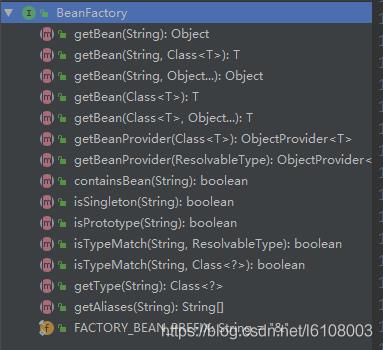Spring解析 XML 的原理,你搞定了么?
Posted Java知音_
tags:
篇首语:本文由小常识网(cha138.com)小编为大家整理,主要介绍了Spring解析 XML 的原理,你搞定了么?相关的知识,希望对你有一定的参考价值。
点击关注公众号,实用技术文章及时了解
来源:blog.csdn.net/l6108003/article/
details/106297618
前言
Spring已经是我们Java Web开发必不可少的一个框架,其大大简化了我们的开发,提高了开发者的效率。同时,其源码对于开发者来说也是宝藏,从中我们可以学习到非常优秀的设计思想以及优雅的命名规范,但因其体系庞大、设计复杂对于刚开始阅读源码的人来说是非常困难的。
所以在此之前首先你得下定决心,不管有多困难都得坚持下去;其次,最好先把设计模式掌握熟练;然后在开始阅读源码时一定要多画UML类图和时序图,多问自己为什么要这么设计?这样设计的好处是什么?还有没有更好的设计?
当然,晕车是难免的,但还是那句话,一定要持之以恒(PS:源码版本
5.1.3.RELEASE)。
正文
熟悉IOC体系结构
要学习Spring源码,我们首先得要找准入口,那这个入口怎么找呢?我们不妨先思考一下,在Spring项目启动时,Spring做了哪些事情。这里我以最原始的xml配置方式来分析,那么在项目启动时,首先肯定要先定位——找到xml配置文件,定位之后肯定是加载——将我们的配置加载到内存,最后才是根据我们的配置实例化(本篇文章只讲前两个过程)。
那么Spring是如何定位和加载xml文件的呢?涉及到哪些类呢?我们先来看张类图:

该图是IOC的体系图,整体上你需要有一个大概的印象,可以看到所有的IOC都是有继承关系的,这样设计的好处就是任何一个子类IOC可以直接使用父类IOC加载的Bean,有点像JVM类加载的双亲委派机制;而红色方框圈起来的是本篇涉及到的重要类,需要着重记忆它们的关系。
图中最重要的两个类是BeanFactory和ApplicationContext,这是所有IOC的父接口。其中BeanFactory提供了最基本的对bean的操作:

而ApplicationContex继承了BeanFactory,同时还继承了MessageSource、ResourceLoader、ApplicationEventPublisher等接口以提供国际化、资源加载、事件发布等高级功能。
我们应该想到平时Spring加载xml文件应该是ApplicationContext的子类,从图中我们可以看到一个叫ClassPathXmlApplicationContext的类,联想到我们平时都会 将xml放到classPath下,所以我们直接从这个类开始就行,这就是优秀命名的好处。
探究配置加载的过程
在ClassPathXmlApplicationContext中有很多构造方法,其中有一个是传入一个字符串的(即配置文件的相对路径),但最终是调用的下面这个构造:
public ClassPathXmlApplicationContext(
String[] configLocations, boolean refresh, @Nullable ApplicationContext parent)
throws BeansException
super(parent);
//创建解析器,解析configLocations
setConfigLocations(configLocations);
if (refresh)
refresh();
首先调用父类构造器设置环境:
public AbstractApplicationContext(@Nullable ApplicationContext parent)
this();
setParent(parent);
public void setParent(@Nullable ApplicationContext parent)
this.parent = parent;
if (parent != null)
Environment parentEnvironment = parent.getEnvironment();
if (parentEnvironment instanceof ConfigurableEnvironment)
getEnvironment().merge((ConfigurableEnvironment) parentEnvironment);
然后解析传入的相对路径保存到configLocations变量中,最后再调用父类AbstractApplicationContext的refresh方法刷新容器(启动容器都会调用该方法),我们着重来看这个方法:
public void refresh() throws BeansException, IllegalStateException
synchronized (this.startupShutdownMonitor)
//为容器初始化做准备
prepareRefresh();
// 解析xml
ConfigurableListableBeanFactory beanFactory = obtainFreshBeanFactory();
// Prepare the bean factory for use in this context.
prepareBeanFactory(beanFactory);
try
// Allows post-processing of the bean factory in context subclasses.
postProcessBeanFactory(beanFactory);
// Invoke factory processors registered as beans in the context.
invokeBeanFactoryPostProcessors(beanFactory);
// Register bean processors that intercept bean creation.
registerBeanPostProcessors(beanFactory);
// Initialize message source for this context.
initMessageSource();
// Initialize event multicaster for this context.
initApplicationEventMulticaster();
// Initialize other special beans in specific context subclasses.
onRefresh();
// Check for listener beans and register them.
registerListeners();
// Instantiate all remaining (non-lazy-init) singletons.
finishBeanFactoryInitialization(beanFactory);
// Last step: publish corresponding event.
finishRefresh();
catch (BeansException ex)
if (logger.isWarnEnabled())
logger.warn("Exception encountered during context initialization - " +
"cancelling refresh attempt: " + ex);
// Destroy already created singletons to avoid dangling resources.
destroyBeans();
// Reset 'active' flag.
cancelRefresh(ex);
// Propagate exception to caller.
throw ex;
finally
// Reset common introspection caches in Spring's core, since we
// might not ever need metadata for singleton beans anymore...
resetCommonCaches();
这个方法是一个典型的模板方法模式的实现,第一步是准备初始化容器环境,这一步不重要,重点是第二步,创建BeanFactory对象、加载解析xml并封装成BeanDefinition对象都是在这一步完成的。
protected ConfigurableListableBeanFactory obtainFreshBeanFactory()
refreshBeanFactory();
return getBeanFactory();
点进去看是调用了refreshBeanFactory方法,但这里有两个实现,应该进哪一个类里面呢?

如果你还记得前面的继承体系,那你就会毫不犹豫的进入AbstractRefreshableApplicationContext类中,所以在阅读源码的过程中一定要记住类的继承体系。
protected final void refreshBeanFactory() throws BeansException
//如果BeanFactory不为空,则清除BeanFactory和里面的实例
if (hasBeanFactory())
destroyBeans();
closeBeanFactory();
try
//创建DefaultListableBeanFactory
DefaultListableBeanFactory beanFactory = createBeanFactory();
beanFactory.setSerializationId(getId());
//设置是否可以循环依赖 allowCircularReferences
//是否允许使用相同名称重新注册不同的bean实现.
customizeBeanFactory(beanFactory);
//解析xml,并把xml中的标签封装成BeanDefinition对象
loadBeanDefinitions(beanFactory);
synchronized (this.beanFactoryMonitor)
this.beanFactory = beanFactory;
catch (IOException ex)
throw new ApplicationContextException("I/O error parsing bean definition source for " + getDisplayName(), ex);
在这个方法中首先会清除掉上一次创建的BeanFactory和对象实例,然后创建了一个DefaultListableBeanFactory对象并传入到了loadBeanDefinitions方法中,这也是一个模板方法,因为我们的配置不止有xml,还有注解等,所以这里我们应该进入AbstractXmlApplicationContext类中:
protected void loadBeanDefinitions(DefaultListableBeanFactory beanFactory) throws BeansException, IOException
//创建xml的解析器,这里是一个委托模式
XmlBeanDefinitionReader beanDefinitionReader = new XmlBeanDefinitionReader(beanFactory);
// Configure the bean definition reader with this context's
// resource loading environment.
beanDefinitionReader.setEnvironment(this.getEnvironment());
//这里传一个this进去,因为ApplicationContext是实现了ResourceLoader接口的
beanDefinitionReader.setResourceLoader(this);
beanDefinitionReader.setEntityResolver(new ResourceEntityResolver(this));
// Allow a subclass to provide custom initialization of the reader,
// then proceed with actually loading the bean definitions.
initBeanDefinitionReader(beanDefinitionReader);
//主要看这个方法
loadBeanDefinitions(beanDefinitionReader);
首先创建了一个XmlBeanDefinitionReader对象,见名知意,这个就是解析xml的类,需要注意的是该类的构造方法接收的是BeanDefinitionRegistry对象,而这里将DefaultListableBeanFactory对象传入了进去(别忘记了这个对象是实现了BeanDefinitionRegistry类的),如果你足够敏感,应该可以想到后面会委托给该类去注册。
注册什么呢?自然是注册BeanDefintion。记住这个猜想,我们稍后来验证是不是这么回事。
接着进入loadBeanDefinitions方法获取之前保存的xml配置文件路径,并委托给XmlBeanDefinitionReader对象解析加载:
protected void loadBeanDefinitions(XmlBeanDefinitionReader reader) throws BeansException, IOException
Resource[] configResources = getConfigResources();
if (configResources != null)
reader.loadBeanDefinitions(configResources);
//获取需要加载的xml配置文件
String[] configLocations = getConfigLocations();
if (configLocations != null)
reader.loadBeanDefinitions(configLocations);
最后会进入到抽象父类AbstractBeanDefinitionReader中:
public int loadBeanDefinitions(String location, @Nullable Set<Resource> actualResources) throws BeanDefinitionStoreException
// 这里获取到的依然是DefaultListableBeanFactory对象
ResourceLoader resourceLoader = getResourceLoader();
if (resourceLoader == null)
throw new BeanDefinitionStoreException(
"Cannot load bean definitions from location [" + location + "]: no ResourceLoader available");
if (resourceLoader instanceof ResourcePatternResolver)
// Resource pattern matching available.
try
//把字符串类型的xml文件路径,形如:classpath*:user/**/*-context.xml,转换成Resource对象类型,其实就是用流
//的方式加载配置文件,然后封装成Resource对象
Resource[] resources = ((ResourcePatternResolver) resourceLoader).getResources(location);
//主要看这个方法
int count = loadBeanDefinitions(resources);
if (actualResources != null)
Collections.addAll(actualResources, resources);
if (logger.isTraceEnabled())
logger.trace("Loaded " + count + " bean definitions from location pattern [" + location + "]");
return count;
catch (IOException ex)
throw new BeanDefinitionStoreException(
"Could not resolve bean definition resource pattern [" + location + "]", ex);
else
// Can only load single resources by absolute URL.
Resource resource = resourceLoader.getResource(location);
int count = loadBeanDefinitions(resource);
if (actualResources != null)
actualResources.add(resource);
if (logger.isTraceEnabled())
logger.trace("Loaded " + count + " bean definitions from location [" + location + "]");
return count;
这个方法中主要将xml配置加载到存中并封装成为Resource对象,这一步不重要,可以略过,主要的还是loadBeanDefinitions方法,最终还是调用到子类XmlBeanDefinitionReader的方法:
public int loadBeanDefinitions(EncodedResource encodedResource) throws BeanDefinitionStoreException
try
//获取Resource对象中的xml文件流对象
InputStream inputStream = encodedResource.getResource().getInputStream();
try
//InputSource是jdk中的sax xml文件解析对象
InputSource inputSource = new InputSource(inputStream);
if (encodedResource.getEncoding() != null)
inputSource.setEncoding(encodedResource.getEncoding());
//主要看这个方法
return doLoadBeanDefinitions(inputSource, encodedResource.getResource());
finally
inputStream.close();
protected int doLoadBeanDefinitions(InputSource inputSource, Resource resource)
throws BeanDefinitionStoreException
try
//把inputSource 封装成Document文件对象,这是jdk的API
Document doc = doLoadDocument(inputSource, resource);
//主要看这个方法,根据解析出来的document对象,拿到里面的标签元素封装成BeanDefinition
int count = registerBeanDefinitions(doc, resource);
if (logger.isDebugEnabled())
logger.debug("Loaded " + count + " bean definitions from " + resource);
return count;
public int registerBeanDefinitions(Document doc, Resource resource) throws BeanDefinitionStoreException
// 创建DefaultBeanDefinitionDocumentReader对象,并委托其做解析注册工作
BeanDefinitionDocumentReader documentReader = createBeanDefinitionDocumentReader();
int countBefore = getRegistry().getBeanDefinitionCount();
//主要看这个方法,需要注意createReaderContext方法中创建的几个对象
documentReader.registerBeanDefinitions(doc, createReaderContext(resource));
return getRegistry().getBeanDefinitionCount() - countBefore;
public XmlReaderContext createReaderContext(Resource resource)
// XmlReaderContext对象中保存了XmlBeanDefinitionReader对象和DefaultNamespaceHandlerResolver对象的引用,在后面会用到
return new XmlReaderContext(resource, this.problemReporter, this.eventListener,
this.sourceExtractor, this, getNamespaceHandlerResolver());
接着看看DefaultBeanDefinitionDocumentReader中是如何解析的:
protected void doRegisterBeanDefinitions(Element root)
// 创建了BeanDefinitionParserDelegate对象
BeanDefinitionParserDelegate parent = this.delegate;
this.delegate = createDelegate(getReaderContext(), root, parent);
// 如果是Spring原生命名空间,首先解析 profile标签,这里不重要
if (this.delegate.isDefaultNamespace(root))
String profileSpec = root.getAttribute(PROFILE_ATTRIBUTE);
if (StringUtils.hasText(profileSpec))
String[] specifiedProfiles = StringUtils.tokenizeToStringArray(
profileSpec, BeanDefinitionParserDelegate.MULTI_VALUE_ATTRIBUTE_DELIMITERS);
// We cannot use Profiles.of(...) since profile expressions are not supported
// in XML config. See SPR-12458 for details.
if (!getReaderContext().getEnvironment().acceptsProfiles(specifiedProfiles))
if (logger.isDebugEnabled())
logger.debug("Skipped XML bean definition file due to specified profiles [" + profileSpec +
"] not matching: " + getReaderContext().getResource());
return;
preProcessXml(root);
//主要看这个方法,标签具体解析过程
parseBeanDefinitions(root, this.delegate);
postProcessXml(root);
this.delegate = parent;
在这个方法中重点关注preProcessXml、parseBeanDefinitions、postProcessXml三个方法,其中preProcessXml和postProcessXml都是空方法,意思是在解析标签前后我们自己可以扩展需要执行的操作,也是一个模板方法模式,体现了Spring的高扩展性。然后进入parseBeanDefinitions方法看具体是怎么解析标签的:
protected void parseBeanDefinitions(Element root, BeanDefinitionParserDelegate delegate)
if (delegate.isDefaultNamespace(root))
NodeList nl = root.getChildNodes();
for (int i = 0; i < nl.getLength(); i++)
Node node = nl.item(i);
if (node instanceof Element)
Element ele = (Element) node;
if (delegate.isDefaultNamespace(ele))
//默认标签解析
parseDefaultElement(ele, delegate);
else
//自定义标签解析
delegate.parseCustomElement(ele);
else
delegate.parseCustomElement(root);
这里有两种标签的解析:Spring原生标签和自定义标签。怎么区分这两种标签呢?
// 自定义标签
<context:component-scan/>
// 默认标签
<bean:/>如上,带前缀的就是自定义标签,否则就是Spring默认标签,无论哪种标签在使用前都需要在Spring的xml配置文件里声明Namespace URI,这样在解析标签时才能通过Namespace URI找到对应的NamespaceHandler。
xmlns:context="http://www.springframework.org/schema/context"
http://www.springframework.org/schema/beansisDefaultNamespace判断是不是默认标签,点进去看看是不是跟我上面说的一致:
public boolean isDefaultNamespace(Node node)
return isDefaultNamespace(getNamespaceURI(node));
public static final String BEANS_NAMESPACE_URI = "http://www.springframework.org/schema/beans";
public boolean isDefaultNamespace(@Nullable String namespaceUri)
return (!StringUtils.hasLength(namespaceUri) || BEANS_NAMESPACE_URI.equals(namespaceUri));
可以看到http://www.springframework.org/schema/beans所对应的就是默认标签。接着,我们进入parseDefaultElement方法:
private void parseDefaultElement(Element ele, BeanDefinitionParserDelegate delegate)
//import标签解析
if (delegate.nodeNameEquals(ele, IMPORT_ELEMENT))
importBeanDefinitionResource(ele);
//alias标签解析
else if (delegate.nodeNameEquals(ele, ALIAS_ELEMENT))
processAliasRegistration(ele);
//bean标签
else if (delegate.nodeNameEquals(ele, BEAN_ELEMENT))
processBeanDefinition(ele, delegate);
else if (delegate.nodeNameEquals(ele, NESTED_BEANS_ELEMENT))
// recurse
doRegisterBeanDefinitions(ele);
这里面主要是对import、alias、bean标签的解析以及beans的字标签的递归解析,主要看看bean标签的解析:
protected void processBeanDefinition(Element ele, BeanDefinitionParserDelegate delegate)
// 解析elment封装为BeanDefinitionHolder对象
BeanDefinitionHolder bdHolder = delegate.parseBeanDefinitionElement(ele);
if (bdHolder != null)
// 该方法功能不重要,主要理解设计思想:装饰者设计模式以及SPI设计思想
bdHolder = delegate.decorateBeanDefinitionIfRequired(ele, bdHolder);
try
// 完成document到BeanDefinition对象转换后,对BeanDefinition对象进行缓存注册
BeanDefinitionReaderUtils.registerBeanDefinition(bdHolder, getReaderContext().getRegistry());
// Send registration event.
getReaderContext().fireComponentRegistered(new BeanComponentDefinition(bdHolder));
public BeanDefinitionHolder parseBeanDefinitionElement(Element ele, @Nullable BeanDefinition containingBean)
// 获取id和name属性
String id = ele.getAttribute(ID_ATTRIBUTE);
String nameAttr = ele.getAttribute(NAME_ATTRIBUTE);
// 获取别名属性,多个别名可用,;隔开
List<String> aliases = new ArrayList<>();
if (StringUtils.hasLength(nameAttr))
String[] nameArr = StringUtils.tokenizeToStringArray(nameAttr, MULTI_VALUE_ATTRIBUTE_DELIMITERS);
aliases.addAll(Arrays.asList(nameArr));
String beanName = id;
if (!StringUtils.hasText(beanName) && !aliases.isEmpty())
beanName = aliases.remove(0);
if (logger.isTraceEnabled())
logger.trace("No XML 'id' specified - using '" + beanName +
"' as bean name and " + aliases + " as aliases");
//检查beanName是否重复
if (containingBean == null)
checkNameUniqueness(beanName, aliases, ele);
// 具体的解析封装过程还在这个方法里
AbstractBeanDefinition beanDefinition = parseBeanDefinitionElement(ele, beanName, containingBean);
if (beanDefinition != null)
if (!StringUtils.hasText(beanName))
try
if (containingBean != null)
beanName = BeanDefinitionReaderUtils.generateBeanName(
beanDefinition, this.readerContext.getRegistry(), true);
else
beanName = this.readerContext.generateBeanName(beanDefinition);
// Register an alias for the plain bean class name, if still possible,
// if the generator returned the class name plus a suffix.
// This is expected for Spring 1.2/2.0 backwards compatibility.
String beanClassName = beanDefinition.getBeanClassName();
if (beanClassName != null &&
beanName.startsWith(beanClassName) && beanName.length() > beanClassName.length() &&
!this.readerContext.getRegistry().isBeanNameInUse(beanClassName))
aliases.add(beanClassName);
if (logger.isTraceEnabled())
logger.trace("Neither XML 'id' nor 'name' specified - " +
"using generated bean name [" + beanName + "]");
catch (Exception ex)
error(ex.getMessage(), ele);
return null;
String[] aliasesArray = StringUtils.toStringArray(aliases);
return new BeanDefinitionHolder(beanDefinition, beanName, aliasesArray);
return null;
// bean的解析
public AbstractBeanDefinition parseBeanDefinitionElement(
Element ele, String beanName, @Nullable BeanDefinition containingBean)
this.parseState.push(new BeanEntry(beanName));
// 获取class名称和父类名称
String className = null;
if (ele.hasAttribute(CLASS_ATTRIBUTE))
className = ele.getAttribute(CLASS_ATTRIBUTE).trim();
String parent = null;
if (ele.hasAttribute(PARENT_ATTRIBUTE))
parent = ele.getAttribute(PARENT_ATTRIBUTE);
try
// 创建GenericBeanDefinition对象
AbstractBeanDefinition bd = createBeanDefinition(className, parent);
// 解析bean标签的属性,并把解析出来的属性设置到BeanDefinition对象中
parseBeanDefinitionAttributes(ele, beanName, containingBean, bd);
bd.setDescription(DomUtils.getChildElementValueByTagName(ele, DESCRIPTION_ELEMENT));
//解析bean中的meta标签
parseMetaElements(ele, bd);
//解析bean中的lookup-method标签
parseLookupOverrideSubElements(ele, bd.getMethodOverrides());
//解析bean中的replaced-method标签
parseReplacedMethodSubElements(ele, bd.getMethodOverrides());
//解析bean中的constructor-arg标签
parseConstructorArgElements(ele, bd);
//解析bean中的property标签
parsePropertyElements(ele, bd);
parseQualifierElements(ele, bd);
bd.setResource(this.readerContext.getResource());
bd.setSource(extractSource(ele));
return bd;
return null;
bean标签的解析步骤仔细理解并不复杂,就是将一个个标签属性的值装入到了BeanDefinition对象中,这里需要注意parseConstructorArgElements和parsePropertyElements方法,分别是对constructor-arg和property标签的解析,解析完成后分别装入了BeanDefinition对象的constructorArgumentValues和propertyValues中,而这两个属性在接下来c和p标签的解析中还会用到,而且还涉及一个很重要的设计思想——装饰器模式。
Bean标签解析完成后将生成的BeanDefinition对象、bean的名称以及别名一起封装到了BeanDefinitionHolder对象并返回,然后调用了decorateBeanDefinitionIfRequired进行装饰:
public BeanDefinitionHolder decorateBeanDefinitionIfRequired(
Element ele, BeanDefinitionHolder definitionHolder, @Nullable BeanDefinition containingBd)
BeanDefinitionHolder finalDefinition = definitionHolder;
//根据bean标签属性装饰BeanDefinitionHolder,比如<bean class="xx" p:username="dark"/>
NamedNodeMap attributes = ele.getAttributes();
for (int i = 0; i < attributes.getLength(); i++)
Node node = attributes.item(i);
finalDefinition = decorateIfRequired(node, finalDefinition, containingBd);
//根据bean标签子元素装饰BeanDefinitionHolder\\
NodeList children = ele.getChildNodes();
for (int i = 0; i < children.getLength(); i++)
Node node = children.item(i);
if (node.getNodeType() == Node.ELEMENT_NODE)
finalDefinition = decorateIfRequired(node, finalDefinition, containingBd);
return finalDefinition;
在这个方法中分别对Bean标签的属性和子标签迭代,获取其中的自定义标签进行解析,并装饰之前创建的BeanDefinition对象,如同下面的c和p:
// c:和p:表示通过构造器和属性的setter方法给属性赋值,是constructor-arg和property的简化写法
<bean class="com.dark.bean.Student" id="student" p:username="Dark" p:password="111" c:age="12" c:sex="1"/>两个步骤是一样的,我们点进decorateIfRequired方法中:
public BeanDefinitionHolder decorateIfRequired(
Node node, BeanDefinitionHolder originalDef, @Nullable BeanDefinition containingBd)
//根据node获取到node的命名空间,形如:http://www.springframework.org/schema/p
String namespaceUri = getNamespaceURI(node);
if (namespaceUri != null && !isDefaultNamespace(namespaceUri))
// 根据配置文件获取namespaceUri对应的处理类,SPI思想
NamespaceHandler handler = this.readerContext.getNamespaceHandlerResolver().resolve(namespaceUri);
if (handler != null)
//调用NamespaceHandler处理类的decorate方法,开始具体装饰过程,并返回装饰完的对象
BeanDefinitionHolder decorated =
handler.decorate(node, originalDef, new ParserContext(this.readerContext, this, containingBd));
if (decorated != null)
return decorated;
else if (namespaceUri.startsWith("http://www.springframework.org/"))
error("Unable to locate Spring NamespaceHandler for XML schema namespace [" + namespaceUri + "]", node);
else
// A custom namespace, not to be handled by Spring - maybe "xml:...".
if (logger.isDebugEnabled())
logger.debug("No Spring NamespaceHandler found for XML schema namespace [" + namespaceUri + "]");
return originalDef;
这里也和我们之前说的一样,首先获取到标签对应的namespaceUri,然后通过这个Uri去获取到对应的NamespceHandler,最后再调用NamespceHandler的decorate方法进行装饰。我们先来看看获取NamespceHandler的过程,这涉及到一个非常重要的高扩展性的思想——SPI
public NamespaceHandler resolve(String namespaceUri)
// 获取spring中所有jar包里面的 "META-INF/spring.handlers"文件,并且建立映射关系
Map<String, Object> handlerMappings = getHandlerMappings();
//根据namespaceUri:http://www.springframework.org/schema/p,获取到这个命名空间的处理类
Object handlerOrClassName = handlerMappings.get(namespaceUri);
if (handlerOrClassName == null)
return null;
else if (handlerOrClassName instanceof NamespaceHandler)
return (NamespaceHandler) handlerOrClassName;
else
String className = (String) handlerOrClassName;
try
Class<?> handlerClass = ClassUtils.forName(className, this.classLoader);
if (!NamespaceHandler.class.isAssignableFrom(handlerClass))
throw new FatalBeanException("Class [" + className + "] for namespace [" + namespaceUri +
"] does not implement the [" + NamespaceHandler.class.getName() + "] interface");
NamespaceHandler namespaceHandler = (NamespaceHandler) BeanUtils.instantiateClass(handlerClass);
//调用处理类的init方法,在init方法中完成标签元素解析类的注册
namespaceHandler.init();
handlerMappings.put(namespaceUri, namespaceHandler);
return namespaceHandler;
// AOP标签对应的NamespaceHandler,可以发现NamespaceHandler的作用就是管理和注册与自己相关的标签解析器
public void init()
// In 2.0 XSD as well as in 2.1 XSD.
registerBeanDefinitionParser("config", new ConfigBeanDefinitionParser());
registerBeanDefinitionParser("aspectj-autoproxy", new AspectJAutoProxyBeanDefinitionParser());
registerBeanDefinitionDecorator("scoped-proxy", new ScopedProxyBeanDefinitionDecorator());
// Only in 2.0 XSD: moved to context namespace as of 2.1
registerBeanDefinitionParser("spring-configured", new SpringConfiguredBeanDefinitionParser());
看到这里我们应该就清楚了Spring是如何解析xml里的标签了以及我们如果要扩展自己的标签该怎么做。只需要创建一个我们的自定义标签和解析类,并指定它的命名空间以及NamespaceHandler,最后在META-INF/spring.handlers文件中指定命名空间和NamespaceHandler的映射关系即可,就像Spring的c和p标签一样:
http\\://www.springframework.org/schema/c=org.springframework.beans.factory.xml.SimpleConstructorNamespaceHandler
http\\://www.springframework.org/schema/p=org.springframework.beans.factory.xml.SimplePropertyNamespaceHandler像这样使用SPI的思想设计我们的项目的话,当需要扩展时,不需要改动任何的代码,非常的方便优雅。
接着,我们回到handler的decorate方法,这里有三个默认的实现类:NamespaceHandlerSupport、SimpleConstructorNamespaceHandler、SimplePropertyNamespaceHandler。
第一个是一个抽象类,与我们这里的流程无关,感兴趣的可自行了解,第二个和第三个则分别是c和p标签对应的NamespaceHandler,两个装饰的处理逻辑基本上是一样的,我这里进入的是SimpleConstructorNamespaceHandler类:
public BeanDefinitionHolder decorate(Node node, BeanDefinitionHolder definition, ParserContext parserContext)
if (node instanceof Attr)
Attr attr = (Attr) node;
String argName = StringUtils.trimWhitespace(parserContext.getDelegate().getLocalName(attr));
String argValue = StringUtils.trimWhitespace(attr.getValue());
ConstructorArgumentValues cvs = definition.getBeanDefinition().getConstructorArgumentValues();
boolean ref = false;
// handle -ref arguments
if (argName.endsWith(REF_SUFFIX))
ref = true;
argName = argName.substring(0, argName.length() - REF_SUFFIX.length());
ValueHolder valueHolder = new ValueHolder(ref ? new RuntimeBeanReference(argValue) : argValue);
valueHolder.setSource(parserContext.getReaderContext().extractSource(attr));
// handle "escaped"/"_" arguments
if (argName.startsWith(DELIMITER_PREFIX))
String arg = argName.substring(1).trim();
// fast default check
if (!StringUtils.hasText(arg))
cvs.addGenericArgumentValue(valueHolder);
// assume an index otherwise
else
int index = -1;
try
index = Integer.parseInt(arg);
catch (NumberFormatException ex)
parserContext.getReaderContext().error(
"Constructor argument '" + argName + "' specifies an invalid integer", attr);
if (index < 0)
parserContext.getReaderContext().error(
"Constructor argument '" + argName + "' specifies a negative index", attr);
if (cvs.hasIndexedArgumentValue(index))
parserContext.getReaderContext().error(
"Constructor argument '" + argName + "' with index "+ index+" already defined using <constructor-arg>." +
" Only one approach may be used per argument.", attr);
cvs.addIndexedArgumentValue(index, valueHolder);
// no escaping -> ctr name
else
String name = Conventions.attributeNameToPropertyName(argName);
if (containsArgWithName(name, cvs))
parserContext.getReaderContext().error(
"Constructor argument '" + argName + "' already defined using <constructor-arg>." +
" Only one approach may be used per argument.", attr);
valueHolder.setName(Conventions.attributeNameToPropertyName(argName));
cvs.addGenericArgumentValue(valueHolder);
return definition;
很简单,拿到c标签对应的值,封装成ValueHolder,再添加到BeanDefinition的ConstructorArgumentValues属性中去,这样就装饰完成了。
讲到这里你可能会觉得,这和平时看到装饰器模式不太一样。其实,设计模式真正想要表达的是各种模式所代表的思想,而不是死搬硬套的实现,只有灵活的运用其思想才算是真正的掌握了设计模式,而装饰器模式的精髓就是动态的将属性、功能、责任附加到对象上,这样你再看这里是否是运用了装饰器的思想呢?
装饰完成后返回BeanDefinitionHolder对象并调用BeanDefinitionReaderUtils.registerBeanDefinition方法将该对象缓存起来,等待容器去实例化。这里就是将其缓存到DefaultListableBeanFactory的beanDefinitionMap属性中,自己看看代码也就明白了,我就不贴代码了。至此,Spring的XML解析原理分析完毕,下面是我画的时序图,可以对照看看:

总结
本篇是Spring源码分析的第一篇,只是分析了refresh中的obtainFreshBeanFactory方法,我们可以看到仅仅是对XML的解析和bean定义的注册缓存,Spring就做了这么多事,并考虑到了各个可能会扩展的地方,那我们平时做的项目呢?看似简单的背后是否有深入思考过呢?
推荐

PS:因为公众号平台更改了推送规则,如果不想错过内容,记得读完点一下“在看”,加个“星标”,这样每次新文章推送才会第一时间出现在你的订阅列表里。点“在看”支持我们吧!
以上是关于Spring解析 XML 的原理,你搞定了么?的主要内容,如果未能解决你的问题,请参考以下文章